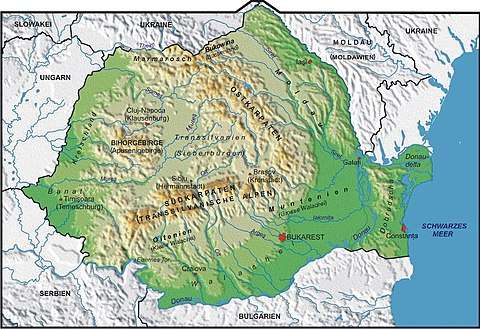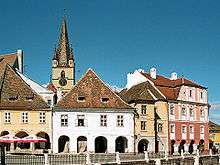Germans of Romania
The Germans of Romania or Rumäniendeutsche represent one of the most important ethnic minorities of Romania. During the interwar period, the total number of ethnic Germans in this country amounted to as much as c. 800,000 (according to some sources and estimates dating to 1939, just on the verge of World War II),[2][3][4] a figure which has subsequently fallen to c. 36,000 (according to the 2011 census).
.png) Map depicting the distribution of ethnic Germans in Romania (according to the 2002 census) | |
| Total population | |
|---|---|
| 36,042[1] | |
| Regions with significant populations | |
| Mainly Transylvania, Banat, and Bukovina | |
| Languages | |
| Mainly German (Hochdeutsch)
Dialects
| |
| Religion | |
| Majority: Lutheranism and Roman Catholicism Minority: Orthodox Christianity | |
| Related ethnic groups | |
| Mainly Germans
Also related
|
Overview and classification of Romanian-Germans
The Germans of Romania (or Romanian-Germans) are not a single, unitary, homogeneous group, but rather a series of various regional sub-groups, each with their afferent culture, traditions, dialects, and history.[5]
This claim stems from the fact that various German-speaking populations had previously arrived in the territory of present-day Romania in different waves or stages of settlement, initially starting with the High Middle Ages, firstly to southern and northeastern Transylvania, Kingdom of Hungary (some of them even crossing the outer Carpathians to neighbouring Moldavia and Wallachia), then subsequently during the Modern Age in other Habsburg-ruled lands (such as Bukovina, at the time part of Cisleithania, or the Banat).[6] Subsequently, the Romanian Old Kingdom was also colonized by Germans, firstly in Dobruja and then gradually in Moldavia and Wallachia.
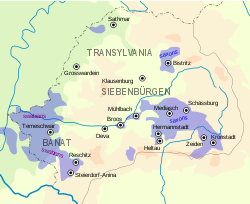
Therefore, given their rather complex geographic background, besides major border changes took place in the region throughout history (after World War I, Romania expanded its territory from the pre-war 137,000 km2 (53,000 sq mi) to 295,049 km2 (113,919 sq mi). In order to understand their language, culture, customs, and history, the Germans of Romania must be regarded as the following independent sub-groups:
- Transylvanian Saxons – the largest and eldest German community in the territory of modern-day Romania (often simply equated with all Romanian-Germans);
- Transylvanian Landlers – expelled Protestants (Evangelical Lutherans) from the region of Salzkammergut, contemporary Austria to southern Transylvania during the 18th century;
- Most Banat Swabians as well as the entirety of the Sathmar Swabians[7] – both representing sub-groups of the Danube Swabians (German: Donau Schwaben) in Romania;
- Bukovina Germans – once with a sizable or overwhelming demographic presence in all urban centres from the historical region of Bukovina (more specifically Suceava, Gura Humorului, Siret, Rădăuți, Vatra Dornei, and Câmpulung Moldovenesc) or some rural areas of the nowadays Suceava County in northeastern Romania; equally indigenous to Cernăuți and contemporary Chernivtsi province in western Ukraine between the years c. 1780–1940. Moreover, even to this date, Suceava County is one of the Romanian counties with some of the most significant amount of ethnic Germans in the country;[8][9]
- Zipser Germans, mostly from Maramureş (including Borșa and Vişeu), but also with a smaller presence in southern Bukovina beginning in the 18th century;[10][11]
- Regat Germans (including the Dobrujan Germans);[12]
- Bessarabia Germans, Romanian citizens for the period 1918–1940, indigenous to Budjak in southern Bessarabia;
- Alsatians as well as small groups of Walsers vintners who also settled in Banat from Alsace, Lorraine, and Switzerland at the invitation of the Austro-Hungarian Empire in the 19th century (though they were not only Alemannic-speaking Swiss but also French and Italian); Subsequently, these settlers came to be known as 'Français du Banat' (i.e. 'Banat French').[13][14][15][16][17]
Contributions to Romanian culture
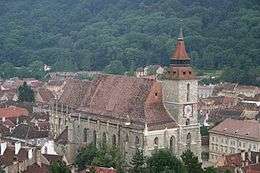
The German community in Romania has been actively and consistently contributing to the culture of the country. Notable examples include:
- Romanian architecture (e.g. the picturesque Transylvanian villages with fortified churches, known in German as kirchenburgen), or some of the most renowned castles as well as several medieval town centers with local markets, all of them highly popular touristic attractions);[18][19][20][21]
- Romanian language (where approximately 3% of the words in the Romanian lexis are of German origin, mainly stemming from the influence of the Transylvanian Saxons and, later on, that of Austrians);[22][23][24][25][26]
- Romanian literature (the first letter written in Romanian was addressed to the former early 16th century mayor of Kronstadt, Johannes Benkner, and the first Romanian language book was printed in Hermannstadt).
Royal House of Hohenzollern-Sigmaringen in Romania
In the time of Romania's transition from a middle-sized principality to a larger kingdom, members of the German House of Hohenzollern (hailing from the Swabian Principality of Hohenzollern-Sigmaringen, part contemporary Baden-Württemberg) reigned initially over the Danubian United Principalities of Moldavia and Wallachia and then, eventually, also over the unified Kingdom of Romania both during the 19th and 20th centuries. Consequently, the ruling Romanian monarchs who were part of this dynastic branch were the following ones:
| King | Reign | Claim | ||||
|---|---|---|---|---|---|---|
| Nº | Portrait | Name (Born–Died) |
Reign start | Reign end | Duration | |
| 1 |  |
Carol I (1839–1914) |
15 March, 1881 | 10 October, 1914 | 33 years, 209 days | Ruled beforehand as Domnitor (i.e. 'Prince') (1866–1881) |
| 2 |  |
Ferdinand I (1865–1927) |
10 October, 1914 | 20 July, 1927 | 12 years, 283 days | Nephew of Carol I |
| 3 | .jpg) |
Michael I (1921–2017) |
20 July, 1927 | 8 June, 1930 (Deposed) |
2 years, 323 days | Grandson of Ferdinand I |
| — | 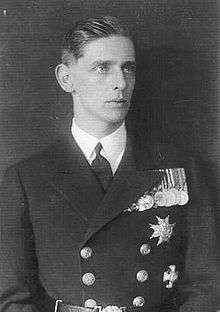 |
Prince Nicholas (1903–1978) |
20 July, 1927 | 8 June, 1930 (Deposed) |
2 years, 323 days | Son of Ferdinand I |
| 4 |  |
Carol II (1893–1953) |
8 June, 1930 | 6 September, 1940 (Abdicated) |
10 years, 90 days | Son of Ferdinand I |
| (3) |  |
Michael I (1921–2017) |
6 September, 1940 | 30 December, 1947 (Abdicated) |
7 years, 115 days | Son of Carol II |
Pretenders to the throne of Romania (after 1947, when King Michael I was forced to abdicate):
| Nº | Portrait | Pretender | Pretending from | Pretending until |
|---|---|---|---|---|
| 1 | 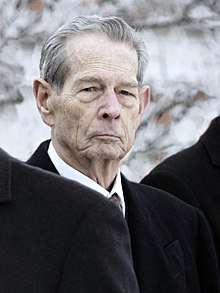 | Michael I | 30 December, 1947 | 1 March, 2016 |
| 2 | Crown Princess Margareta | 1 March, 2016 | present | |
Recent history (20th century onwards)
.png)
Between the two World Wars, namely in 1925, c. 20,000 Swabians from Timiș County had to be relocated to Arad County in order to create an ethnic balance in the respective administrative unit.[27]
Large numbers of Romanian-Germans were deported to the Soviet Union as forced labour after World War II, and later in the 1950s the Bărăgan deportations forcibly relocated many from near the Yugoslav border to the Bărăgan Plain. Survivors of both groups generally returned, but had often lost their properties in the process.[28][29]
Furthermore, during the 1970s and 1980s, tens of thousands of Romanian-Germans were 'bought back' by the West German government under a program to reunite families - and following the collapse of Nicolae Ceaușescu's regime in December 1989, around 200,000 Germans left their homes in Romania.[30]
Although the German minority in Romania has dwindled in numbers to a considerable extent since the fall of the Iron Curtain, the few but well organised Romanian-Germans who decided to remain in the country after the 1989 revolution are respected and regarded by many of their fellow ethnic Romanian countrymen as a hard-working, thorough, and practical community which contributed tremendously to the local culture and history of, most notably, Transylvania, Banat, and Bukovina, where the largest German-speaking groups once lived alongside the Romanian ethnic majority.[31]
Furthermore, the bilateral political and cultural relationships between post–1989 Romania and the unified Federal Republic of Germany have seen a continuous positive evolution since the signing of a friendship treaty between the two countries in 1992.[32] Additionally, on the occasion of the election of Frank-Walter Steinmeier as President of Germany in 2017, current Romanian president Klaus Johannis stated, among others, that: "[...] Last but not least, there is a profound friendship bounding the Romanians and the Germans, thanks mainly to the centuries-long cohabitation between the Romanians, Saxons, and Swabians in Transylvania, Banat, and Bukovina."[33]
Demographics
| Historical population | ||
|---|---|---|
| Year | Pop. | ±% |
| 1887 | 50,000 | — |
| 1930 | 745,421 | +1390.8% |
| 1939 | 786,000 | +5.4% |
| 1948 | 343,913 | −56.2% |
| 1956 | 384,708 | +11.9% |
| 1966 | 382,595 | −0.5% |
| 1977 | 359,109 | −6.1% |
| 1992 | 119,462 | −66.7% |
| 2002 | 59,764 | −50.0% |
| 2011 | 36,042 | −39.7% |
| Starting with the 1930 figures, the reference is to all German-speaking groups in Romania. | ||
Current population by settlement
The data displayed in the table below highlights notable settlements (of at least 1%) of the German minority in Romania according to the 2011 Romanian census. Note that some particular figures might represent a rough estimate.
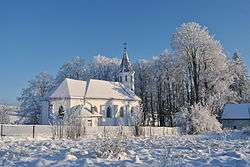
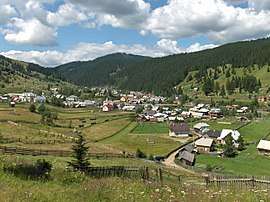
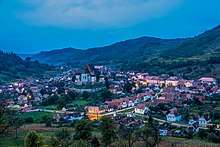


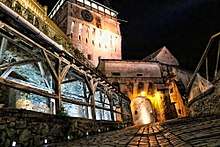

| Romanian name | German name | Percent[34] | County |
|---|---|---|---|
| Brebu Nou | Weidenthal | 30.2 | Caraș-Severin |
| Petrești | Petrifeld | 27.8 | Satu Mare |
| Urziceni | Schinal | 23.9 | Satu Mare |
| Cămin | Kalmandi | 22.5 | Satu Mare |
| Beltiug | Bildegg | 11.4 | Satu Mare |
| Tiream | Terem | 10.9 | Satu Mare |
| Laslea | Grosslasseln | 7.5 | Sibiu |
| Anina | Steierdorf | 5.6 | Caraș-Severin |
| Ațel | Hatzeldorf | 5.3 | Sibiu |
| Cârlibaba | Mariensee/Ludwigsdorf | 5.1 | Suceava |
| Saschiz | Keisd | 5.0 | Mureș |
| Biertan | Birthälm | 4.6 | Sibiu |
| Ardud | Erdeed | 4.5 | Satu Mare |
| Vișeu de Sus | Oberwischau | 4.0 | Maramureș |
| Deta | Detta | 4.0 | Timiș |
| Tomnatic | Triebswetter | 3.9 | Timiș |
| Semlac | Semlak | 3.6 | Arad |
| Peregu Mare | Deutschpereg | 3.5 | Arad |
| Sântana | Sanktanna | 2.9 | Arad |
| Jimbolia | Hatzfeld | 2.9 | Timiș |
| Jibert | Seiburg | 2.8 | Brașov |
| Măieruş | Nussbach | 2.6 | Brașov |
| Căpleni | Kaplau | 2.4 | Satu Mare |
| Lovrin | Lowrin | 2.3 | Timiș |
| Carei | Grosskarol | 2.3 | Satu Mare |
| Parța | Paratz | 2.1 | Timiș |
| Buziaș | Busiasch | 2.1 | Timiș |
| Periam | Perjamosch | 2.1 | Timiș |
| Sânnicolau Mare | Grosssanktnikolaus | 2.1 | Timiș |
| Pâncota | Pankota | 2.1 | Arad |
| Cristian | Neustadt | 1.9 | Brașov |
| Lenauheim | Schadat | 1.9 | Timiș |
| Lugoj | Logosch | 1.9 | Timiș |
| Miercurea Sibiului | Reussmarkt | 1.8 | Sibiu |
| Rupea | Reps | 1.7 | Brașov |
| Sânpetru | Petersberg | 1.7 | Brașov |
| Ungra | Galt | 1.7 | Brașov |
| Reșița | Reschitz | 1.7 | Caraș-Severin |
| Ciacova | Tschakowa | 1.6 | Timiș |
| Cisnădie | Heltau | 1.5 | Sibiu |
| Mediaș | Mediasch | 1.5 | Sibiu |
| Moșna | Meschen | 1.5 | Sibiu |
| Sighișoara | Schässburg | 1.5 | Mureș |
| Oțelu Roșu | Ferdinandsberg | 1.4 | Caraș-Severin |
| Timișoara | Temeschburg/Temeswar | 1.4 | Timiș |
| Nițchidorf | Nitzkydorf | 1.4 | Timiș |
| Hălchiu | Heldsdorf | 1.4 | Sibiu |
| Merghindeal | Mergeln | 1.3 | Sibiu |
| Beba Veche | Altbeba | 1.3 | Timiș |
| Iacobeni | Jakobsdorf | 1.3 | Sibiu |
| Lipova | Lippa | 1.3 | Arad County |
| Homorod | Hamruden | 1.2 | Brașov |
| Hărman | Honigberg | 1.2 | Brașov |
| Matei | Mathesdorf | 1.2 | Bistrița-Năsăud |
| Sebeș | Mühlbach | 1.1 | Alba |
| Becicherecu Mic | Kleinbetschkerek | 1.1 | Timiș |
| Caransebeș | Karansebesch | 1.1 | Caraș-Severin |
| Bod | Brenndorf | 1.1 | Brașov |
| Brateiu | Pretai | 1.0 | Brașov |
| Bocșa | Neuwerk | 1.0 | Caraș-Severin |
| Satu Mare | Sathmar | 1.0 | Satu Mare |
| Sibiu | Hermannstadt | 1.0 | Sibiu |
| Mănăstirea Humorului | Humora Kloster | 1.0 | Suceava |
| Agnita | Agnetheln | 1.0 | Sibiu |
| Hoghilag | Halvelagen | 1.0 | Sibiu |
| Dumbrăveni | Elisabethstadt | 1.0 | Sibiu |
| Șeica Mare | Marktschelken | 1.0 | Sibiu |
| Codlea | Zeiden | 1.0 | Brașov |
| Gătaia | Gattaja | 1.0 | Timiș |
| Măureni | Moritzfeld | 1.0 | Caraș-Severin |
Current population by county
Below is represented the notable German minority population (of at least 1%) for some counties, according to the 2011 census.
| County | Percent[34] |
|---|---|
| 1.5% | |
| 1.3% | |
| 1.1% | |
| 1.1% | |
Administration, official representation, and politics

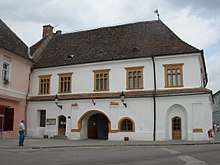
In the wake of World War I, the German minority in unified Romania had been represented by a number of political parties which gradually gained parliamentary presence during the early to mid-early 20th century, more specifically the Swabian Group, the Group of Transylvanian Saxons, the German Party (which briefly formed an alliance known as the Hungarian German Bloc with the Magyar Party), and the German People's Party (the latter two having a national socialist political orientation after 1930). In stark contrast to the political mutation of both aforementioned parties, the Anti-Fascist Committee of German Workers in Romania was formed shortly thereafter as a democratic counterpart. After the end of World War II, all of the political parties representing the German minority in Romania were either disbanded or ceased to exist.
Subsequently, just after the Romanian Revolution, the entire German-speaking community in post-1989 Romania has been represented at official level by the Democratic Forum of Germans in Romania (German: Demokratisches Forum der Deutschen in Rumänien, Romanian: Forumul Democrat al Germanilor din România). The forum is therefore a political platform which has a centrist ideology aiming to support the rights of the German minority in Romania.
Since 1989, the DFDR/FDGR has competed both in local and legislative elections, cooperating in the process with two historical parties of the Romanian politics, namely the National Liberal Party (PNL) and the Christian Democratic National Peasants' Party (PNȚCD), most notably at local administrative level, in cities such as Sibiu (German: Hermannstadt), Timișoara (German: Temeschburg), or Baia Mare (German: Frauenbach or Neustadt). The DFDR/FDGR also adheres to a pro-monarchic stance regarding the matter of monarchy restoration in Romania.
Until 1 January, 2007 (i.e. the date of accession of Romania to the European Union), the DFDR/FDGR was also an observing member of the European Parliament, briefly affiliated with the European People's Party (German: Europäische Volkspartei), between January and November of the same year.
Culture and education
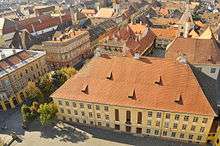
In 1922, all political representatives of the German community in Romania founded the Cultural League of Germans in Sibiu which was initially led by Richard Csaki. The league was in charge of organizing post-university summer courses, sending books, and providing teaching material through various lecturers in the settlements inhabited by ethnic Germans.[35]
Nowadays, there are two German-language schools in Bucharest, namely Deutsche Schule Bukarest and Deutsches Goethe-Kolleg Bukarest. The Deutsche Schule Bukarest serves Kinderkrippe, Kindergarten, Grundschule, and Gymnasium (high school).[36]
In Timișoara, the Nikolaus Lenau High School was founded during the late 19th century. It was named this way in reference to Nikolaus Lenau, a Banat Swabian Romanticist poet. Nowadays, the Nikolaus Lenau High School is considered the most important of its kind from Banat.[37]
In Sibiu, the Samuel von Brukenthal National College is the oldest German-language school from Romania (recorded as early as the 14th century), being also classified as a historical monument. It was subsequently renamed this way in reference to baron Samuel von Brukenthal, a Transylvanian Saxon aristocrat. Additionally, there is one Goethe Institut cultural centre based in Bucharest as well as five Deutsche Kultzertrum based in Iași, Brașov, Cluj-Napoca, Timișoara, Sibiu.[38]
Media
The Allgemeine Deutsche Zeitung für Rumänien (ADZ) is the daily German-language newspaper in contemporary Romania. To this day, it is the only German-language newspaper published in Eastern Europe.[39] Regional German-language publications also include the Neue Banater Zeitung in Banat and the Hermannstädter Zeitung for the city of Sibiu (German: Hermannstadt). Previously, in the passing of time, other historical German-language newspapers included: Arbeiter-Zeitung and Banater Arbeiter-Presse in Banat, Vorwärts in Bukovina, and Neuer Weg in Bucharest.
Gallery
 Historical coat of arms of the Transylvanian Saxons
Historical coat of arms of the Transylvanian Saxons Historical coat of arms of the Bukovina Germans
Historical coat of arms of the Bukovina Germans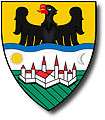 Historical coat of arms of the Banat Swabians
Historical coat of arms of the Banat Swabians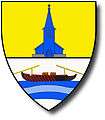 Historical coat of arms of the Sathmar Swabians
Historical coat of arms of the Sathmar Swabians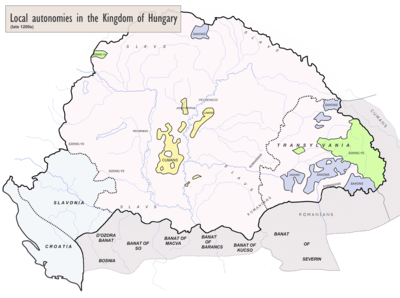 13th century map of the Kingdom of Hungary highlighting Saxon-populated areas
13th century map of the Kingdom of Hungary highlighting Saxon-populated areas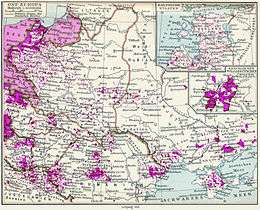 Distribution of ethnic Germans in Central and Eastern Europe in 1925, also highlighting German settlements in the Kingdom of Romania
Distribution of ethnic Germans in Central and Eastern Europe in 1925, also highlighting German settlements in the Kingdom of Romania Traditional areas of settlement for the Saxons and Swabians in Transylvania and Banat, Kingdom of Romania (at the round of the 20th century)
Traditional areas of settlement for the Saxons and Swabians in Transylvania and Banat, Kingdom of Romania (at the round of the 20th century)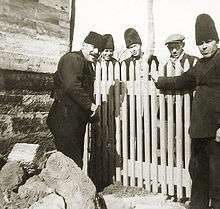 A group of Bessarabian Germans (c. 1935)
A group of Bessarabian Germans (c. 1935)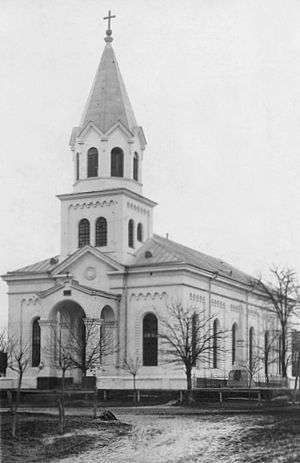
 Evangelical Lutheran Church in Tarutino
Evangelical Lutheran Church in Tarutino A group of Banat Swabians in 1940, celebrating 'Kirchweih' (or 'Kerwei' in their local dialect)[40]
A group of Banat Swabians in 1940, celebrating 'Kirchweih' (or 'Kerwei' in their local dialect)[40]- A Dobrujan German in Culelia
.jpg) The ruins of the Evangelical Lutheran church of Malcoci (German: Malkotsch) of the Dobrujan Germans in Tulcea County
The ruins of the Evangelical Lutheran church of Malcoci (German: Malkotsch) of the Dobrujan Germans in Tulcea County
_b_005.jpg) Transylvanian Saxon couple from Bistrița (German: Bistritz/Nösen) area
Transylvanian Saxon couple from Bistrița (German: Bistritz/Nösen) area
 Traditional Saxon woman costume from Brașov (German: Kronstadt)
Traditional Saxon woman costume from Brașov (German: Kronstadt)
See also
- Germany–Romania relations
- Germany–Moldova relations
- List of ambassadors of Germany to Romania
- Romanians in Germany
- Transylvanian Saxon dialect
- Villages with fortified churches in Transylvania
- List of fortified churches in Transylvania
- List of Transylvanian Saxon localities
- Group of Transylvanian Saxons
- List of famous Transylvanian Saxons
- Sibiu Lutheran Cathedral
- Siebenbürgenlied
- Transylvanian Museum (in Gundelsheim, Baden-Württemberg, south-western Germany)
- Association of Transylvanian Saxons in Germany
- German culture
- Geographical distribution of German speakers
References
- Official Romanian census from 2011
- Dr. Gerhard Reichning, Die deutschen Vertriebenen in Zahlen, Teil 1, Bonn 1995, Page 17
- Die deutschen Vertreibungsverluste. Bevölkerungsbilanzen für die deutschen Vertreibungsgebiete 1939/50. Herausgeber: Statistisches Bundesamt – Wiesbaden. - Stuttgart: Kohlhammer Verlag, 1958 Page 46
- "Romania's ethnic Germans get their day in the spotlight". Deutsche Welle. Retrieved 7 April 2020.
- Daniel Ursprung (2015). "The German Minority in Romania: a Historical Overview" (PDF). University of Zürich. Retrieved 21 June 2020.
- Dr. Hans Georg Franchy, Horst Göbbel, Heide Wellmann, Annemarie Wagner, Werner Reschner (2010). "Wir Nösner, Beiträge zur Geschichte und Kultur der Stadt Bistritz und des Nösnerlandes" (PDF). HOG Bistritz-Nösen e.V. (in German). Retrieved 27 June 2020.CS1 maint: multiple names: authors list (link)
- Monica Barcan, Adalbert Millitz, The German Nationality in Romania (1978), page 42: "The Satu Mare Swabians are true Swabians, their place of origin being Württemberg, in the land of Baden-Württemberg. They were colonized between 1712 and 1815. Their most important settlements are Satu Mare (German: Sathmar) and Petrești (German: Petrifeld) in northwestern Romania."
- Ministry of Foreign Affairs of Romania (3 May 2013). "The 16th session of the Romanian-German Joint Governmental Commission on the problems of German ethnics in Romania". Press release. Retrieved 17 June 2018.
- Thomas Nägler. "The Germans in Romania". Institul Cultural Român (ICR). Retrieved 20 March 2020.
- Oskar Hadbawnik, Die Zipser in der Bukowina (1968) discusses the Zipserfest held in Jakobeny in 1936 to commemorate 150 years since the Zipsers migrated to Jakobeny in 1786.
- І. Я. Яцюк, Тернопільський національний педагогічний університет ім. Володимира Гнатюка, Наукові записки. Серія “Філологічна”, УДК 81’282.4:811.112.2(477): Lexikalische Besonderheiten Deutscher Dialekte in Galizien- und der Bukowina: “Die Siedler in den ursprünglichen Bergwerksgemeinden im Südwesten der Bukowina sprachen Zipserisch und zwar Gründlerisch, wie es in der Unterzips gesprochen wurde. Dabei wurde [v] im Anlaut wie [b] ausgesprochen: Werke – berka, weh – be, Schwester – schbesta. Anlautendes [b] wurde zu [p]: Brot – prot, Brücke – prik.”
- Forumul Democrat al Germanilor din Constanța (2003). "On the Germans of Dobrogea". Institutul Cultural Român. Retrieved 1 October 2018.
- Identity and multiculturalism in the Romanian Banat, Remus Creţan, David Turnock and Jaco Woudstra, p. 17-26
- Perjamosch, Banat/List of Families Connected to Hubert Family
- Association pour la promotion de l'Alsace en Roumanie: L’étonnante histoire des alsaciens et lorrains du Banat. (in French)
- The French in Banat: Story on Tomnatic/Triebswetter
- Smaranda Vultur. "De l'Ouest à l'Est et de l'Est à l'Ouest: les avatars identitaires des Français du Banat". Memoria.ro (in French). Retrieved 23 May 2020.
- Victor Rouă (27 May 2017). "The History Of The Medieval Saxon Fortified Churches In Transylvania". The Dockyards. Retrieved 24 June 2020.
- Victor Rouă (22 September 2015). "Top 5 Transylvanian Saxon Fortified Churches". The Dockyards. Retrieved 24 June 2020.
- Victor Rouă (14 October 2015). "10 Mesmerising Medieval Landmarks of Transylvania". The Dockyards. Retrieved 24 June 2020.
- Victor Rouă (4 September 2015). "Top Five Transylvanian Saxon Fortified Cities You Should Visit In Romania". The Dockyards. Retrieved 24 June 2020.
- Dimitrie Macrea, "Originea și structura limbii române", Probleme de lingvistică română (Bucharest: Editura Științifică, 1961), 7–45: p. 32.
- Academia Română, Dicționarul limbii române moderne, ed. Dimitrie Macrea (Bucharest: Editura Academiei, 1958).
- Gabriela Pană Dindelegan, ed., The Grammar of Romanian, Oxford University Press, 2013, p. 3, ISBN 978-0-19-964492-6
- Hans Dama, "Lexikale Einflüsse im Rumänischen aus dem österreichischen Deutsch" ("Lexical influences of 'Austrian'-German on the Romanian Language") Archived 2011-08-18 at the Wayback Machine (in German)
- ""Șmecher", "fraier" și "mișto". Cum au apărut în limba română și ce însemnau inițial aceste cuvinte". Alba24.ro (in Romanian). 28 April 2020. Retrieved 27 June 2020.
- "Istoria Transilvaniei - Istoria până la 1914". România Turistică (in Romanian). Retrieved 28 March 2020.
- Chuck Sudetic (28 December 1990). "Ethnic Germans in Romania Dwindle". The New York Times. Retrieved 19 March 2020.
- Ovidiu Hațegan (2 February 2020). "AUDIO Povestea deportării etnicilor germani din România, prin ochii Katarinei Meitert. "Nemții", primele victime ale "salvatorilor" sovietici". G4media (in Romanian). Retrieved 23 June 2020.
- Abraham, Florin (25 September 2017). Romania since the Second World War: A Political, Social and Economic History.
- Ziarul Românesc.de | Klaus Iohannis: «Germanii din România sunt apreciați și respectați de toți românii» (in Romanian)
- Ministerul Afacerilor Externe - 25 de ani de la semnarea tratatului de prietenie România-Germania (in Romanian)
- Digi24.ro | Mesajul lui Iohannis pentru președintele ales al Germaniei (in Romanian)
- Denotes percent (%) of total population
- Vasile Ciobanu. "Relațiile culturale dintre grupurile de germani din România în primul deceniu interbelic" (PDF). Țara Bârsei (in Romanian). Retrieved 23 June 2020.
- "Entstehung Archived 2015-02-15 at the Wayback Machine." Deutsche Schule Bukarest. Retrieved on 20 February 2015.
- (in German) Geschichte Temeswars Schulwesen
- Locations - Goethe-Institut (in English)
- Internationale Funkausstellung Berlin (in German)
- Banaters.com - Kerwei
